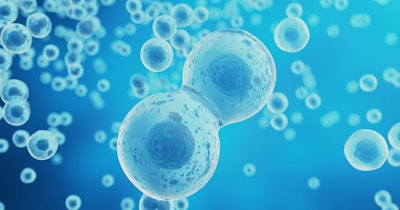
Risk biomarkers uncovered in a recent study may help medical staff predict which donor stem cell transplant patients are likely to develop a potentially deadly side effect called sinusoidal obstruction syndrome (SOS).
The study, published in JCI Insight, may be the first prospective biomarker analyses for donor stem cell transplants, according to the researchers.
While stem cell transplants can cure blood cancers and other disorders, serious potential side effects include SOS — blockage of veins in the liver, potentially leading to multi-organ failure and death. SOS is less common than graft-versus-host disease following donor stem cell transplants, but still occurs in a significant number of patients (12.5% in this study).
SOS can be harder to diagnose in pediatric patients, and there are no clear risk factors indicating which patients are more likely to develop it. While the drug defibrotide is approved to treat SOS, previous studies showed that proactively giving the drug to all transplant patients had no clear benefits. Since defibrotide is expensive, it is also more feasible to limit it to those who would benefit.
In a previous study, the team gathered blood samples from children who developed SOS and identified potential biomarkers. These included ST2, a receptor used as a cardiac stress biomarker; hyaluronic acid, known as an anti-aging ingredient in skin care products, but also a connective tissue component used as a liver fibrosis biomarker; and L-ficolin, a protein expressed in the liver that plays a role in the innate immune system.
In this study, conducted at four academic medical centers nationwide, researchers sought to determine the point at which these potential biomarkers started showing unusual levels. They tested 80 patients’ plasma three days after stem cell transplantation and seven days after stem cell transplantation. As SOS typically occurs within a month of transplant, they presumed these points in time would provide sufficient time for effective treatment.
The researchers found that measuring the biomarkers on day three did indicate which patients would develop SOS. Using a combination of the three biomarkers, patients with positive scores were found to be 9.3 times more likely to develop SOS; they were also more likely to die within 100 days of transplantation.
Besides identifying patients at risk of SOS, the biomarkers may also be used to monitor how patients are responding to defibrotide treatment. If future larger group studies show the biomarkers to be effective trackers, doctors could better decide when patients no longer need defibrotide, rather than administering standard 21-day treatments to all patients.
The researchers hope defibrotide’s manufacturer will conduct multicenter clinical trials to find out whether giving the drug to patients who test positive for risk biomarkers before showing symptoms can prevent SOS from developing.
“Most of my colleagues on this study are physicians and see a lot of patients being affected by this, so they really want to move this forward,” co-author Dr. Sophie Paczesny, MUSC Hollings Cancer Center researcher, noted in a statement. “That’s my dream. These patients really need it.”



















